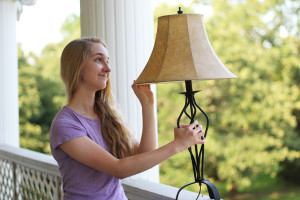by Haley Mitchell, online & photography editor
You’ve probably heard of the Bechdel test. For a movie to pass the Bechdel test, it has to have two named women characters in it who talk to each other about something other than a man.
But what about the Ellen Willis test? The Mako Maori test? The Deggans Rule?
The entertainment industry is always changing, but not fast enough for my taste. Every week a new movie about a white guy who does something dangerous comes out―it’s the same basic story and it even sometimes stars the same white guy actor. But in an increasingly diverse world where women are no longer limited to three occupations (mother, wife, cook) and one skin tone, the media is being forced to portray real people. And it is still failing to do so.
So I’ve done you the liberty of identifying the only test you need to know (for now) when you watch a movie. It’s called the sexy lamp test. And it is changing the world.
“FRAGILE. That must be Italian!”
If you’ve heard that famous line then you too must’ve seen the historic scene from “A Christmas Story” when Ralph’s entire family gathers in the living room as his father unveils the arrival of a prized leg lamp. If you haven’t seen “A Christmas Story,” then sorry because I just sort of ruined that scene for you.
But anyways, back to the lamp.
That leg lamp, with its saucy fishnet stocking and fringed shade, is a stereotypical sexy lamp, but for those of us with more unconventional imaginations, any ole lamp will do.
So picture this lamp.
This is your sexy lamp.
Now picture a movie with a female character.
She can be anyone; she can be Peggy Carter or Lieutenant Uhura or Cho Chang or Tauriel (ew).
If she can be replaced by your sexy lamp and the movie still makes sense, then this movie fails the sexy lamp test.
This test is so simple, but while it’s unconventional, it’s incredibly effective at weeding out those movies with just plain bad writing. It’s so easy to write bad characters–characters who do nothing more than stand there and hold something (a gun, a lightsaber, the Declaration of Independence). They have little to no backstory, no real motivation or reason behind their actions and they add nothing to the development of the plot. Sadly, many of these characters are female, and they’re just sexy lamps.
(For example, some notable sexy lamps are: Penny during season one of The Big Bang Theory, Princess Buttercup from The Princess Bride, Amy Pond during her first season of Doctor Who and Jane’s sister Tess in 27 Dresses.) While some of these sexy lamps do show character development, they do nothing to add to the plot of these movies/T.V. shows and are therefore the victims of bad writing. Boo.
After a lot of thought on this topic, I’ve decided that, yes, sometimes sexy lamps are necessary, both in your household decor and in plot-lines. And sometimes men are sexy lamps too (shout out to the Australian Thunder From Down Under and their appearance in Alexander and the Terrible Horrible No Good Very Bad Day). But these necessary sexy lamps should never be more than a minor character with a few lines (also known as extras). Beyond that, they’re just badly written static characters.
Thankfully most writing has moved past this stage, but the fact that this is the most minimal feminist (sorry for using the scary f word) test and some movies still fail is a pretty sad reflection on some people’s perception of women. Past the fact that the sexy lamp test can point out which movies are just bad, it also shows how important female characters are to a story.
So don’t be a sexy lamp―in character, not in aesthetic (if you wanna wear fishnet stockings, you do you). And don’t write your characters as sexy lamps, either. Be an important lamp. Be the best, brightest possible lamp you can be, and you will already be doing more than The Woman in the BBC series Sherlock ever did.



Pingback: On unlikeable characters | Bennett North
Pingback: ‘The Man from U.N.C.L.E.’ licensed to kill the competition
Any character who’s dialogue is responded to by other characters cannot fail the sexy lamp test; because characters responding to a lamp’s dialogue cannot “still make sense”.
Ok, well, take out the dialogue. Does the plot still move? In a lot of cases, yes. The character might speak but what she says doesn’t move the plot, so taking it out and taking out reactions would still count.